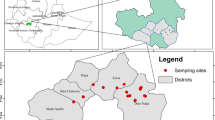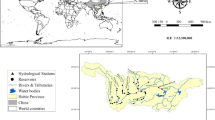Abstract
In the Himalayan region, most of the glacier deposits showed a shrinking trend by the present global climate change scenario. In most cases, seasonal variations in the frequency of snowfall rate, short melting period, and rapid runoff of water have been felt. This realized us to develop sustainable snow water harvesting technology from the seasonal snowfall to irrigate the maximum dry land (cultivable and suitable wasteland) during summer rainless months. Climatic data from automatic weather stations will pave the trend of climate change effect and useful to understand the seasonal variation of local weather. For the conservation of water, the study is appropriate for dry areas of the cold desert by constructing a sequence of improved underground poly-tanks, desilting tanks well connected with defined catchment areas. Simultaneously, the strength quality of the constructed different designed tanks was tested for longer durability. Over the few years, the pace of rapidly melting permanent glaciers occurred in the cold desert Himalayas, and hence shortage for availability of irrigation water has been felt. This work gives us technological solutions towards adaptation measures against climate change by tapping of the water from seasonal winter fresh snowfall (otherwise wasted by runoff), which is not attempted seriously yet. This technology is helpful to harness maximum sustainable water harvesting potential and find an additional source other than the prevailing system of harvesting from the permanent source of glaciers/avalanches. It is also useful for the improvement of ecosystem diversity, productivity, and implementation of various policy schemes in the mountainous regions of the World.





Similar content being viewed by others
Availability of data and materials
Not applicable.
Code availability
Not applicable.
References
Ageta Y, Iwata S, Yabuki H, Naito N, Sakai A, Narama C, Karma N (2000) Expansion of glacier lakes in recent decades in the Bhutan Himalayas. In: Nakawo M, Raymond CF, Fountain A (eds) Debris‐covered glaciers, vol 246. International Association of Hydrological Sciences Publications, pp 165–175
Anonymous (2011) District Census handbook Lahaul and Spiti: village and town dictionary, Himachal Pradesh, Census of India 2011. Directorate of Census operations Himachal Pradesh, Ministry of Home Affairs, Government of India. Series 3: Part XII A
Armstrong RL, Rittger K, Brodzik MJ, Racoviteanu A, Barrett AP, Khalsa S-JS, Raup B, Hill AF, Khan AL, Wilson AM, Kayastha RB, Fetterer F, Armstrong B (2019) Runoff from glacier ice and seasonal snow in High Asia: separating melt water sources in river flow. Reg Environ Change 19:1249–1261
Bhuchar S, Billingsley A, Dhakal M, Providoli I, Sherpa SL, Siddiqi AS (2009) Integrated snow and water harvesting and low-cost irrigation, pp 83_99. In: Mountain development resource book for Afghanistan. International Centre for Integrated Mountain Development Kathmandu Nepal, p 149.
Burton WK (1898) The water supply of tows and the construction of waterworks. Crosby Lockwood and Son:London, UK, p 320, https://www.nationalgeographic.com/magazine/2017/04/explore-desert-glaciers/. Accessed 25 June 2022
Casassa G, Haeberli W, Jones G, Kaser G, Ribstein P, Rivera A, Schneider C (2007) Current status of Andean glaciers. Glob Planet Change 59:1–9. https://doi.org/10.1016/j.gloplacha.2006.11.013
Chambers DP (2009) Calculating trends from GRACE in the presence of large changes in continental ice storage and ocean mass. Geophys J Int 176:415–419. https://doi.org/10.1111/j.1365-246X.2008.04012.x
Chewang N (1998) Water harvesting in Trans Himalayan Region; traditional technique (Zing) and contemporary technique (artificial glaciers). copyright © Centre for Science and Environment. www.rainwaterharvesting.org. Accessed 25 Jun 2022
Fujita K (2008) Influence of precipitation seasonality on glacier mass balance and its sensitivity to climate change. Ann Glaciol 48:88–92. https://doi.org/10.3189/172756408784700824.
Hoelzle M, Haeberli W, Dischl M, Peschke W (2003) Secular glacier mass balances derived from cumulative glacier length changes. Glob Planet Change 36:295–306. https://doi.org/10.1016/S0921-8181(02)00223-0
Immerzeel WW, Beek LPH, Bierkens MFP (2010) Climate change will affect the Asian water towers. Science 328:1382–1385. https://doi.org/10.1126/science.1183188
Iyngararasan M, Tianchi L, Shrestha S, Mool PK, Yoshino M, Watanabe T (2004) The challenges of mountain environments. In: Price MF, Jansky LF, Iatsenia AA (eds) Water, natural resources, hazards, desertification, and the implications of climate change. Key issues for mountain areas. United Nations University Press, Tokyo, pp 18_37
de Jong C (2015) Challenges for mountain hydrology in the third millennium. Front Environ Sci 3:38. https://doi.org/10.3389/fenvs.2015.00038
Kujur A, Singh D (2013) Groundwater information booklet Lahaul and Spiti District, Himachal Pradesh. Northern Himalayan Region Dharamshala. Ministry of Water Resources, Central Ground Water Board. Govt. of India
Kumar V, Singh P, Singh V (2007) Snow and glacier melt contribution in the Beas River at Pandoh Dam, Himachal Pradesh, India. Hydrol Sci J 52(2):376–388. https://doi.org/10.1623/hysj.52.2.376
Li X, He Y, Yang X, He X, Pang H, Jia W, Zhang C, Yuan L, He H, Zuo X (2007) Response of “glacier-runoff” system in a typical monsoonal temperate glacier region, Hailuogou Basin in Mt. Gongga of China, to global warming. Hydrol Earth Syst Sci 4:3395–3412. https://doi.org/10.5194/hessd-4-3395-2007
Mall RK, Gupta A, Singh R, Singh RS, Rathore LS (2006) Water resources and climate change: an Indian perspective. Curr Sci 90(12):1610–1625
Moiwo JP, Yang Y, Tao F, Lu W, Han S (2011) Water storage change in the Himalayas from the Gravity Recovery and Climate Experiment (GRACE) and an empirical climate model. Water Resour Res 47(7):W07521. https://doi.org/10.1029/2010WR010157
Muskett R (2008) GRACE equivalent water mass balance of the Himalayas and Tibet Plateau region. Geophysical research abstracts 10: abstract EGU2008‐A‐01606
Nusser M, Baghel R (2016) Local knowledge and global concerns: artificial glaciers as a focus of environmental knowledge and development interventions. In: Meusburger P et al (eds) Ethnic and cultural dimensions of knowledge. Springer, Dordrecht, pp 191–209
Ostrom E, Benjamin P (1993) Design principles and the performance of farmer managed irrigation systems in Nepal. In: Manor S, Chambouleyron J (eds) Performance measurement in farmer managed irrigation systems. IIMI, pp 53–62
Phuntsog T, Wani MA, Dawa S, Hussain S, Rai AP (2016) Water harvesting and conservation under the cold desert condition of Ladakh (J&K): constraints and strategies. Glob J Bio-Sci Biotechnol 5(4):457–460
Qiu J (2008) The third pole. Nature 454:393–396. https://doi.org/10.1038/454393a
Ren JW, Qin DH, Kang SC, Hou SG, Pu JC, Jin ZF (2003) Glacier variations and climate warming and drying in the central Himalayas. Chin Sci Bull 48(23):2478–2482
Scott CA, Zhang F, Mukherji A, Immerzeel W, Mustafa D, Bharati L (2019) Water in the Hindu Kush Himalaya. In: Wester P, Mishra A, Mukherji A, Shrestha A (eds) The Hindukush Himalaya Assessment, pp 257–299, Springer Cham. https://doi.org/10.1007/978-3-319-92288-1_8
Sivanappan RK (2006) Rain water harvesting, conservation and management strategies for urban and rural sectors. National seminar on rainwater harvesting and water management 11–12 Nov 2006, Nagpur
Tang M, Li C (1992) Fact analysis on the Tibetan Plateau as a startup area of climate change. In: Collected papers of the first academic seminar of the Chinese Committee on Tibetan Plateau Research. Beijing Science Press, Beijing, pp 42–53
Thapa B, Scott CA, Wester P, Varady R (2016) Towards characterizing the adaptive capacity of farmer-managed irrigation systems: learnings from Nepal. Curr Opin Environ Sustain 21:37–44
Thapa KB (1993) Estimation of snowmelt runoff in Himalayan catchments incorporating remote sensing data, in snow and glacier hydrology. In: Proceedings of the Kathmandu symposium, November 1992, vol 218. IAHS Publisher, pp 96–74
Vishvakarma SCR, Rawat YS, Oinam SS, Kuniyal JC (2004) Kuhl irrigation: a community management system in the cold desert of the Lahaul valley, northwestern Himalaya, India. In: Proceedings of the third international seminar. Farmer managed irrigation systems and governance alternatives. Kathmandu, Nepal, September, pp 425–444
Wang QW, Hidema J, Hikqsaka K (2014) Is UV-induced DNA damage greater at High elevation? Am J Bot 101(5):796–802
Acknowledgements
The author wants to acknowledge the Director of CSIR-Institute of Himalayan Bioresource Technology Palampur (HP) India for administrative support and encouragement. The weather data received from Dr. Amit Chawla and encouragement received from Dr. Anil Sood of CSIR-IHBT Palampur Himachal Pradesh India are highly acknowledged. I also want to thank Er. R.K. Verma, Er. Anil Kaundal, Mr. Sunil Kumar, Mr. Shubam for their Technical support. The paper is approved for the communication by the internal review committee with publication no. 4109.
Funding
Financial help received from the CSIR- New Delhi India (Project code BSC209) is acknowledged.
Author information
Authors and Affiliations
Contributions
The author has initiated the idea for technological work, designed and implemented, data collection/ compilation and manuscript writing.
Corresponding author
Ethics declarations
Conflict of interest
It is declared that the paper has no conflict of interest.
Additional information
Publisher's Note
Springer Nature remains neutral with regard to jurisdictional claims in published maps and institutional affiliations.
Rights and permissions
About this article
Cite this article
Singh, A. Sustainable snowmelt water harvesting technology: an irrigation water solution under climate change effect in the dry cold deserts, Indian Himalayan region—a case study. Sustain. Water Resour. Manag. 8, 103 (2022). https://doi.org/10.1007/s40899-022-00679-0
Received:
Accepted:
Published:
DOI: https://doi.org/10.1007/s40899-022-00679-0




